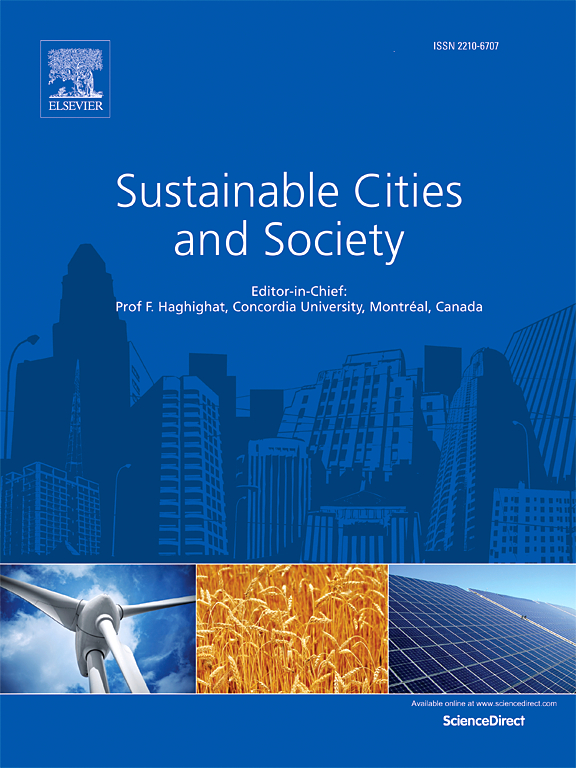基于内涝风险角的城市内涝风险预警分类新框架
IF 10.5
1区 工程技术
Q1 CONSTRUCTION & BUILDING TECHNOLOGY
引用次数: 0
摘要
城市内涝风险预警分级是提高城市可持续水安全、有效减少内涝灾害的主要防控措施。提出了内涝风险角(WRA)的概念,并结合已构建的InfoWorks ICM模型,将其应用于确定城市内涝风险预警分类。结果表明:(1)随降雨持续时间的增加,WRA值逐渐减小。锋峰暴雨的WRA值趋于较大,使内涝灾害更容易发生。(2) FPR一级和二级相同持续时间的城市内涝风险预警时间(EWTUWR)均小于峰后暴雨预警时间。平均EWTUWR随降雨持续时间的增加而增加,1 h降雨持续时间对应的平均EWTUWR最小。(3)不同降水持续时间的EWTUWRs与暴雨特征之间存在紧密的关系。随着前峰暴雨强度(FPRI)和总降雨量(TRV)的增加,预警时间缩短。(4)理论验证和实际验证证明了所提出的预警时间是可行的、适用的。本研究为其他城市内涝风险预警研究提供了一种新的方法。本文章由计算机程序翻译,如有差异,请以英文原文为准。
A new framework for early-warning classification of urban waterlogging risk based on waterlogging risk angle
Early-warning classification of urban waterlogging risk is the main prevention and control measure to improve urban sustainable water security and effectively reduce waterlogging disasters. The concept of waterlogging risk angle (WRA) is proposed and applied to determine the early-warning classification of urban waterlogging risk combing with the constructed InfoWorks ICM model. The results show that (1) with the increase of rainfall duration, the WRA value gradually decreases. And the WRA value of front-peak rainstorm (FPR) tends to be larger, which makes waterlogging disasters easier to occur. (2) The early-warning time of urban waterlogging risk (EWTUWR) in the same duration of level I and level II of FPR is all less than that of behind-peak rainstorm (BPR). Moreover, the average EWTUWR increases with the rainfall duration, with 1 h rainfall duration corresponding to the smallest average EWTUWR. (3) There has a compactly relations between EWTUWRs and rainstorm characteristics in different rainfall durations. The early-warning time is shortened by the increase of front-peak rainstorm intensity (FPRI) and total rainfall volume (TRV). (4) The theoretical verification and practical verification prove that the proposed early-warning time is available and applicable. This study provides a new method for studying the early-warning of urban waterlogging risk in other cities.
求助全文
通过发布文献求助,成功后即可免费获取论文全文。
去求助
来源期刊

Sustainable Cities and Society
Social Sciences-Geography, Planning and Development
CiteScore
22.00
自引率
13.70%
发文量
810
审稿时长
27 days
期刊介绍:
Sustainable Cities and Society (SCS) is an international journal that focuses on fundamental and applied research to promote environmentally sustainable and socially resilient cities. The journal welcomes cross-cutting, multi-disciplinary research in various areas, including:
1. Smart cities and resilient environments;
2. Alternative/clean energy sources, energy distribution, distributed energy generation, and energy demand reduction/management;
3. Monitoring and improving air quality in built environment and cities (e.g., healthy built environment and air quality management);
4. Energy efficient, low/zero carbon, and green buildings/communities;
5. Climate change mitigation and adaptation in urban environments;
6. Green infrastructure and BMPs;
7. Environmental Footprint accounting and management;
8. Urban agriculture and forestry;
9. ICT, smart grid and intelligent infrastructure;
10. Urban design/planning, regulations, legislation, certification, economics, and policy;
11. Social aspects, impacts and resiliency of cities;
12. Behavior monitoring, analysis and change within urban communities;
13. Health monitoring and improvement;
14. Nexus issues related to sustainable cities and societies;
15. Smart city governance;
16. Decision Support Systems for trade-off and uncertainty analysis for improved management of cities and society;
17. Big data, machine learning, and artificial intelligence applications and case studies;
18. Critical infrastructure protection, including security, privacy, forensics, and reliability issues of cyber-physical systems.
19. Water footprint reduction and urban water distribution, harvesting, treatment, reuse and management;
20. Waste reduction and recycling;
21. Wastewater collection, treatment and recycling;
22. Smart, clean and healthy transportation systems and infrastructure;
 求助内容:
求助内容: 应助结果提醒方式:
应助结果提醒方式:


